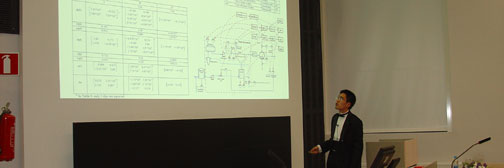| | Year 1996
Janne VarvemaaImprovement of the paper machine short circulation stability by the use of new retention aid and filler system control strategies
The object of this thesis was to develop and apply new control strategies on the retention aid and filler systems in order to improve the stability of the paper machine short circulation. The work was carried out on UPM Kaipola PM 7.
Reliable online measurement of thin stock consistency has made retention control possible. During the PAMIRE-project a wire water total consistency control strategy was developed. This strategy is capable of stabilizing the wire retention of total solids by controlling the retention aid flow. Filler dosage is usually based on paper filler content measurement. Lack of measurement during web breaks and slow response of the process create problems in this control strategy.
Wire water consistency and paper filler content are heavily cross-correlated because of the short circulation properties. Dilution water from the wire pit is responsible for most of the filler in headbox stock, thus changes in filler retention have a strong effect on paper filler content. Changes in the dosage or composition of furnish components alter the amount of filler entering the short circulation and affect the wire retention. While both systems are controlled, they have a tendency to fluctuate because of each other. Process disturbancies and situation such as grade, furnish or speed changes may cause heavy vibrations of retention aid and filler flows. Even web breaks may occur because of this unstability of the short circulation.
In the literature survey short circulation properties concerning retention and filler systems, different pulp properties, relevant online measurements and simple control strategies were studied.
In the experimental part a simple multivariable control strategy was developed to control retention aid and filler systems. These subprocesses were identified and modelled by advanced mathematical tools. Simulation was used to develop a control strategy based on static decoupling of wire water total consistency and paper filler content controls. The main idea of this strategy is to distinquish between two disturbations that affect both wire water consistency and paper filler content: disturbancy in retention and change in filler content of the short circulation. In the second part of the work a filler dosage control strategy during web breaks based on headbox filler consistency was applied. Decoupling was used with this control scheme as well.
The decoupled control strategy turned out to be superior in comparison with the old strategy, when different process variations occurred. Retention aid and filler flow vibrations were reduced by approximately 70 percent during grade, furnish and speed changes and other, sometimes unexplained disturbancies. Signal processing was used to study the system. Even during a good running period of the paper machine fluctuations of retention aid and filler systems was reduced. Headbox filler consistency control during web breaks was efficient in reducing the paper filler content variations.
As a whole the new control strategies improved especially the accuracy of the paper filler content control and the operation of retention and filler systems during different process disturbancies. Furthermore, based on the reduction of vibrations of the retention aid and filler flows while wire water consistency and paper filler content remained stable, it is safe to assume that the filler retention was stabilised. Although unstudied, this fact should have a straight impact on the stability of paper quality.
Deprecated: strlen(): Passing null to parameter #1 ($string) of type string is deprecated in C:\WWWroot\Root\incs\5_theses\theses_new2010.php on line 248
This info last modified 27 Apr 2024 - contact webmaster
|

